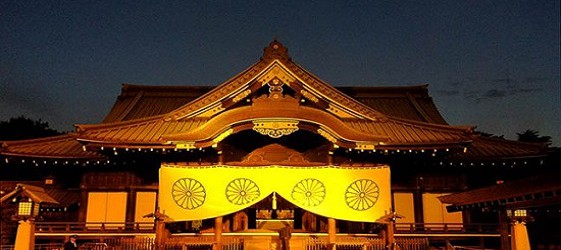It was not the wars but some other means that were employed in the struggle between the major powers on the geopolitical scene in the post-WWII era. Although, on one hand, presence of nuclear arms in the arsenal played its part, another significant factor is associated with the application of tools of pressure and influence, proven more efficient than warfare. In this sense, diplomacy has become a crucial factor on the geopolitical scene.
From the outset of the new millennium unconventional diplomatic moves have surfaced. Time and again, we hear such terms as environmental diplomacy, water geopolitics and sports diplomacy. An event that occurred in Japan late last year introduced a new term to the diplomatic lexicon – shrine diplomacy.
Visit to the Yasukuni Shrine by Japan’s Prime Minister Shinzo Abe, on 26 December 2013, sparked a diplomatic scandal. Officials from the People’s Republic of China, South Korea and Russia expressed their outrage over the incident. This by far, is the only subject where even positions of China and Taiwan coincide. Speaking about the issue, China’s UN representative said: “Abe’s visit is an insolent challenge to the world’s victory against fascism. Japanese Prime Minister’s action is an affront to the post WWII international order based on UN Charter. The Yasukuni Shrine is a spiritual tool and symbol of Japanese militarism in its war of aggression” (1). Apparently, Japanese Prime Minister’s visit to some shrine is regarded as a move capable of impacting geopolitical processes. It is not accidental that the “Diplomat” magazine described it as a “new cold war” (2). Now the rest of the world is fascinated by the significance the Yasukuni Shrine bears.
The Yasukuni Shrine
Yasukuni is a Shinto shrine near Tokyo, built upon the decree of Emperor Meiji in 1869 to commemorate those who lost their lives during the civil war. Distinguishing feature of the Yasukuni is that it honor the souls of those fallen for Japan and its Emperor. Japan’s Emperor is viewed as the living deity of the shrine. Since its foundation and until the WWII, Yasukuni featured names of 2.5 million people who perished in 11 wars. By attending the shrine for worshipping, people regard enshrined individuals who sacrificed their lives for the Emperor as deities.
The war that claimed most Japanese lives in history was the WWII. Names of some 2.1 million people killed during that war were enshrined in Yasukuni. Names of 1068 individuals sentenced to death after the war, including the Prime Minister and 13 generals convicted of crimes against humanity, are also enshrined there. The site also boasts a monument to the Indian justice Radhabinod Pal – the only judge to demand acquittal of the Japanese soldiers under trial in the Tokyo process.
Therefore, China that suffered from the Japanese aggression in the first half of the XX century and Japan’s former colony Korea regard the Yasukuni Shrine as a symbol of Japanese military prowess. Visit to the shrine by the Japanese officials is thus viewed as an act of militarism, dishonoring the memory of the victims of the Japanese aggression.
New geopolitical circumstances in the Asia-Pacific basin
It was before long that despite its defeat in the WWII, Japan joined the ranks of the economic giants. This was primarily attributed to new political situation entailed by the Communists rising to power in China. Growth of socialism and Soviet influence in China and other countries of the East Asia conditioned America’s alignment with Japan. Thus, thanks to support of its once archenemy – the U.S. – Japan became major regional economic power. In the meantime, it has to be acknowledged that having had taken disarmament obligations, Japan was not in a position to make its voice heard in the Pacific.
New millennium witnesses completely new landscape in the East Asia-Pacific basin. Albeit Japan ranks among the world’s economic giants, its neighbors are also rapidly developing. On the other hand, the U.S. is interested in the aggravation of relations between the states in the region because China phenomenon already raises the alert in the America. Under such circumstances, Japan refuses to tolerate any further the fact that it’s weak and obligations-ridden. Therefore, Japanese officials resort to shrine diplomacy in the third millennium. Such a diplomatic move has two notable aspects.
First, in modern times, Japanese officials are using Yasukuni Shrine not for traditional homage purposes but rather for swift response to the processes. Japan’s former Prime Minister Junichiro Koizumi (2001-2006) also visited the very shrine to impact relations with China and South Korea. Interestingly, as of 1978 the Japanese emperors are not visiting the shrine the supreme living deities of which they are deemed to be. Instead, this traditional move is used to express frustration of the Japanese diplomacy.
Second, rise and ambitions of China have provoked new geopolitical situation in the region. Muscle flexing over Senkaku (Diaoyu) islands in 2013 and China’s establishment of the Air Defense Identification Zone in the East China Sea only aggravated the relations between the two countries. In the meantime, new national security strategy of Japan, adopted last December, identified China as the main source of threat.
Thus, under the new geopolitical circumstances, Japan can no longer tolerate absence of military power as part of post-WWII restrictions. This would require position of the U.S. to be made clear. With the adversaries around the world in abundance, the U.S. is not rushing to engage the tensions in the region. Japan, in turn, has turned the Yasukuni shrine into a diplomatic tangle, which is further entangled by the visits of the Japanese officials. Apparently, Yasukuni is the new “Gordian knot” of the Japanese diplomacy.
Arastü HABIBBEYLİ
PhD in Economics
REFERANSLAR
- http://russian.china.org.cn/international/txt/2014-01/09/content_31139342.htm
- http://thediplomat.com/2014/01/the-new-cold-war-china-vs-japan
Kaynak: Newtimes.az
























































